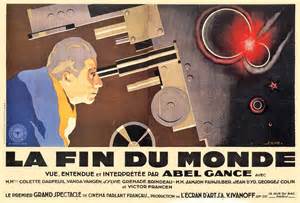Yikes! An asteroid is heading for Earth, threatening to wipe out the entire planet Sounds like METEOR, DEEP IMPACT, ARMAGEDDON and a host of other modern-day disaster pics, but it’s actually THE END OF THE WORLD, filmmaker Abel Gance’s 1931 epic, albeit in a bowdlerized version.
THE ENDOF THE WORLD (Trailer)
THE END OF THE WORLD (LA FIN DU MONDE) is often referred to as Abel Gance’s greatest folly, an under-funded epic that was a critical and financial cataclysm. Gance of course was the genius creator of the masterful 1927 NAPOLEON, as well as innovative works like BEETHOVEN and J’ACCUSE! THE END OF THE WORLD may have been poorly received, but it makes for a fascinating addition to Gance’s oeuvre, being his premiere sound film. Also, as the first true disaster movie the film’s historical value is undeniable.
However, THE END OF THE WORLD was taken away from Gance by its producers before he was finished cutting. As if that weren’t enough, it was considerably pared down in 1934 for release on the American road show circuit, from its initial 105-minute running time to just 53 minutes, complete with a ridiculous English language introduction by real-life astronomer Clyde Fisher (who imparts nuggets like “It seems there is nothing changeable but eternal unchangeableness”) and inexplicably retitled PARIS AFTER DARK. The film in its original version still exists (and played on French television in early 2006), but the most readily available form is the PARIS AFTER DARK abridgement (available on VHS from Something Weird Video).
Some trivia: Guy Maddin’s award-winning short THE HEART OF THE WORLD was apparently inspired by the present film, although Maddin admittedly hadn’t seen it. Also, LA FIN DU MONDE was initially supposed to be the name of the film-within-a-film of John Carpenter’s MASTERS OF HORROR segment “Cigarette Burns”, but was changed to LA FIN ABSOLUE DU MONDE so it wouldn’t conflict with Gance’s title.
Novalic, a leading scientist, spies a comet through a high-powered telescope. He convenes a meeting of delegates from various countries where he airs the bad news: the comet will hit the Earth in 30 days and end life as we know it!
The news quickly makes its way into newspapers around the world. People at first poo-poo the info; an intertitle reads, “The luxury and lust of humanity, its hysterical intoxications, go on and on, deaf to all warning”.
Police arrive at Novalic’s laboratory to arrest him on charges of treason. Before they arrive, however, he orders his subordinates to save all his precious documents and affects an escape. From there Novalic desperately tries to radio his fellow scientists in order to avert the coming disaster.
But it’s already too late, as the deadly comet has become visible in the skies. Widespread panic overtakes the Earth, from the big cities, where mass prayer meetings and wild orgies break out, to the “savage” nations and animal populations, who rightly sense an imminent cataclysm. In addition, hurricanes and volcanoes occur with increasing frequency.
In the midst of the madness Novalic and his aides gather in his abandoned laboratory, where they plot a new world order devoted to peace. Several of the world’s delegates once again make their way to Novalic’s lab, where he fills them in on the details of his plan.
It turns out they needn’t have bothered, as the comet passes by the Earth without touching it. But its presence in the sky did wreak quite a bit of havoc on the planet’s ecosystem and will forever serve as a stern reminder that our time here is limited, so we might as well make the best of it!
As it stands THE END OF THE WORLD/PARIS AFTER DARK has snatches of brilliance, particularly in the many layered images. This is to say that quite a few shots are superimposed over one another (an unprecedented innovation back in 1931) in an artful and poetic manner that can only be due to the genius of Abel Gance, and not the slezemeisters who recut the film. There are also some great moments in the final scenes, with rapid intercutting and distorted lenses accentuating the insanity overtaking the Earth.
Then again, there are also moments of startling silliness that are probably due to the recutters, but I can’t be sure. At times the film is downright Ed Woodian, as when the effect of the approaching comet on the world’s aquatic life is demonstrated by showing goldfish jostled around in a fishbowl! The whole thing has a choppy, discordant flow, which I know is the fault of the recutters, who’ve turned the material into a 53-minute montage that clumsily incorporates silent movie intertitles to fill in the narrative gaps (a crucial subplot involving Gance himself as the protagonist’s saintly brother has been eliminated). I will admit the film in its abridged cut is an intriguing oddity, but it makes me long to see THE END OF THE WORLD in its original and definitive version.
Vital Statistics
THE END OF THE WORLD (LA FIN DU MONDE; PARIS AFTER DARK)
L’Ecran d’Art/Harold Auten
Director: Abel Gance
Producer: K. Ivanov
Screenplay: Abel Gance, Andre Lang, Camille Flammarion
Cinematography: Maurice Foster, Roger Hubert, Jules Kruger
Editing: Mme. Bruyere, Mme. Marguerite
Cast: Clyde Fisher, Victor Francen, Philippe Hersent, Collette Darfeuil, Sylvie Grenade, Jeanne Brindeau, Jean d’Yd, Georges Colin, Abel Gance, Samson Fainsilber, Vanda Greville

